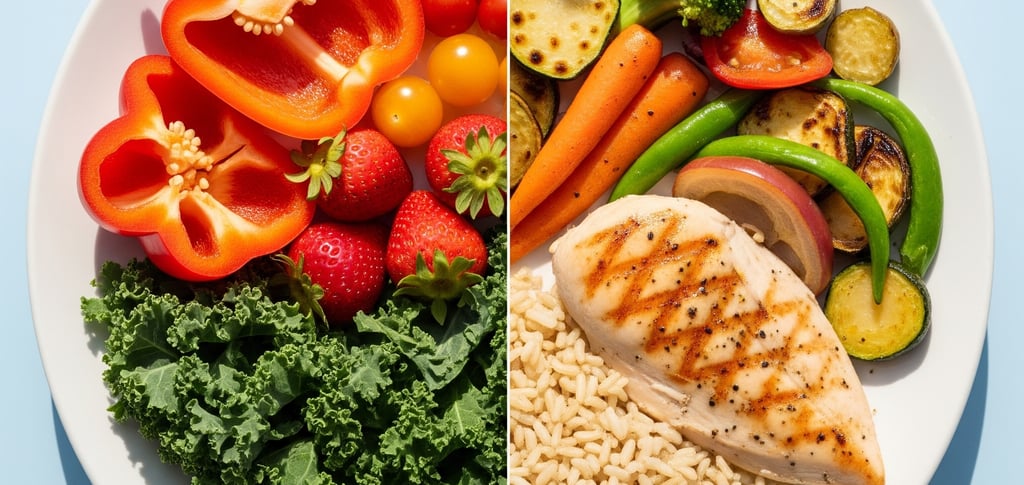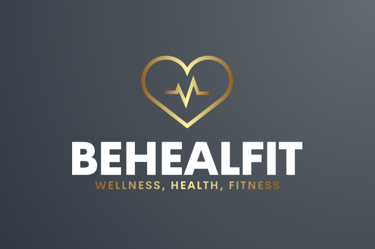Raw vs. Cooked: Unlocking Optimal Nutrition – Which Foods Truly Work Better for Your Body?
Raw vs. Cooked foods: Discover which offers more nutrients & benefits. Learn when to eat raw and when to cook for optimal digestion & health.
HEALTHBLOG-LIST
6/27/20256 min read


In Brief
The debate between raw and cooked foods has fueled nutrition discussions for decades. While raw food enthusiasts champion enzyme preservation and nutrient integrity, proponents of cooking highlight improved digestibility and enhanced bioavailability of certain compounds. So, which approach is truly "better" for your body? The truth is, it's not a simple black-and-white answer. This article delves into the science behind both raw and cooked preparations, revealing which foods truly work better in each form and offering a balanced perspective to help you unlock optimal nutrition and support your unique digestive needs.
Table of Contents
The Raw vs. Cooked Debate: A Historical Perspective
The Power of Raw Foods: Benefits and Best Choices
Nutrient Preservation (Enzymes, Heat-Sensitive Vitamins)
Fiber Integrity and Hydration
Foods Best Consumed Raw
The Advantage of Cooked Foods: Benefits and Optimal Choices
Increased Nutrient Bioavailability
Improved Digestibility and Pathogen Elimination
Foods Best Consumed Cooked
The "Best of Both Worlds" Approach: Finding Your Balance
Testimonial: Emily's Journey to Balanced Eating
Practical Tips for Optimizing Your Raw & Cooked Food Intake
Frequently Asked Questions (FAQ) on Raw vs. Cooked Foods
Conclusion: Variety and Balance – The Key to Optimal Health
1. The Raw vs. Cooked Debate: A Historical Perspective
For millennia, human ancestors relied heavily on raw foods. However, the discovery of fire and cooking revolutionized human evolution, offering distinct survival advantages. Today, the "raw food movement" advocates for a diet primarily (or entirely) composed of uncooked and unprocessed foods, emphasizing the preservation of natural enzymes and nutrients. Yet, cooking remains a cornerstone of global cuisines.
This debate isn't merely philosophical; it's rooted in how different preparation methods impact:
Nutrient Content: How heat affects vitamins, minerals, and phytonutrients.
Digestibility: How cooking alters food structure, making it easier or harder to break down.
Bioavailability: How readily nutrients are absorbed and utilized by the body.
Food Safety: The role of heat in eliminating harmful pathogens.
Understanding these impacts is key to determining which foods thrive in their raw state and which are enhanced by heat.
2. The Power of Raw Foods: Benefits and Best Choices
Consuming foods in their raw state often means preserving their most delicate compounds.
Nutrient Preservation (Enzymes, Heat-Sensitive Vitamins)
Enzyme Activity: Raw foods contain live enzymes, which proponents believe aid digestion and metabolic processes. Cooking above certain temperatures (typically 118°F/48°C to 160°F/71°C, depending on the enzyme) can denature these enzymes.
Heat-Sensitive Vitamins: Vitamins like Vitamin C and some B vitamins (especially folate and thiamine) are highly susceptible to degradation by heat. Eating foods rich in these vitamins raw ensures maximum intake.
Fiber Integrity and Hydration
Fiber Integrity: Raw fruits and vegetables often retain their full fiber structure, which can promote optimal gut health and regularity.
High Water Content: Many raw foods, especially fruits and vegetables, have a high water content, contributing significantly to daily hydration.
Foods Best Consumed Raw
Most Fruits: Berries, citrus fruits, apples, bananas, grapes – excellent raw sources of Vitamin C, antioxidants, and fiber.
Leafy Green Vegetables: Spinach, kale, lettuce, arugula – ideal for salads, rich in Vitamin C, folate, and antioxidants.
Bell Peppers: High in Vitamin C, best eaten raw to preserve it.
Onions, Garlic (chopped/crushed): Raw allicin in garlic is beneficial, though cooking can create other beneficial compounds.
Nuts and Seeds: Raw nuts and seeds contain healthy fats, fiber, and heat-sensitive vitamins (like Vitamin E) that are best preserved uncooked. (Soaking/sprouting can improve digestibility).
3. The Advantage of Cooked Foods: Benefits and Optimal Choices
Cooking, far from being detrimental, can unlock certain nutrients, improve safety, and enhance digestibility.
Increased Nutrient Bioavailability
Enhanced Absorption: Cooking can break down cell walls and complex structures, making certain nutrients more available for absorption. For example, lycopene in tomatoes and beta-carotene in carrots and sweet potatoes are more bioavailable after cooking.
Elimination of Anti-nutrients: Some raw foods contain compounds (e.g., phytates in legumes and grains, oxalates in spinach/rhubarb) that can inhibit mineral absorption. Cooking, soaking, and sprouting can reduce these anti-nutrients.
Improved Digestibility and Pathogen Elimination
Easier Digestion: Cooking softens tough fibers, breaks down complex proteins, and denatures some anti-nutrients, making foods easier to chew, swallow, and digest, especially for individuals with sensitive digestive systems.
Pathogen Elimination: Heat effectively kills harmful bacteria, viruses, and parasites that can be present in raw foods (especially meats, poultry, eggs, and some vegetables grown in contaminated soil), significantly improving food safety.
Foods Best Consumed Cooked
Legumes: Beans, lentils, chickpeas – cooking is essential to break down indigestible starches and eliminate toxins (like lectins) that can cause severe digestive upset.
Grains: Rice, quinoa, oats – require cooking to be digestible and palatable.
Starchy Vegetables: Potatoes, sweet potatoes, winter squash – cooking breaks down complex starches, making them edible and digestible.
Cruciferous Vegetables (for some): Broccoli, cauliflower, cabbage – while beneficial raw, cooking can reduce gas and bloating for sensitive individuals.
Tomatoes: Cooking significantly increases the bioavailability of lycopene, a powerful antioxidant.
Carrots: Cooking enhances the bioavailability of beta-carotene, a precursor to Vitamin A.
Meat, Poultry, Eggs, Fish (most types): Cooking is crucial for food safety to eliminate pathogens.
4. The "Best of Both Worlds" Approach: Finding Your Balance
The most effective approach to nutrition is often a balanced one, integrating the strengths of both raw and cooked foods. This involves:
Diversifying Your Diet: Eating a wide variety of foods prepared in different ways.
Listening to Your Body: Paying attention to how different foods and preparation methods affect your digestion and energy levels. Some individuals thrive on more raw foods, while others require more cooked items for comfort and nutrient absorption.
Strategic Preparation: Choosing cooking methods that minimize nutrient loss (steaming, light sautéing) and maximize bioavailability.
This balanced approach allows you to harness the full spectrum of nutrients and benefits that nature offers.
5. Testimonial: Emily's Journey to Balanced Eating
"For years, I was strictly raw vegan, convinced it was the only way to get all my nutrients. While I felt good initially, I struggled with persistent bloating and a constant feeling of coldness, especially in winter. I'd also get really tired trying to digest tough raw veggies. Then, I read about the benefits of cooked foods for specific nutrients and digestibility. I slowly started incorporating lightly steamed vegetables, cooked lentils, and some baked sweet potatoes into my diet. The change was incredible! My bloating significantly reduced, I felt warmer, and my energy levels became much more stable. My digestion improved dramatically, and I realized I was actually absorbing nutrients better. It wasn't about choosing one over the other, but about finding the right balance for my body. It truly transformed my well-being!" – Emily S.
6. Practical Tips for Optimizing Your Raw & Cooked Food Intake
Start Your Day Raw: A fruit smoothie or a fruit salad can be a great way to get raw nutrients early.
Raw as a Base: Use leafy greens as the base for many meals (salads).
Lightly Cook for Key Nutrients: Lightly steam broccoli or carrots to enhance certain nutrient availability while retaining some heat-sensitive vitamins.
Cook Grains and Legumes Thoroughly: Always cook these properly to ensure digestibility and safety.
Include Fermented Foods: Sauerkraut, kimchi (raw, fermented vegetables) offer probiotics.
Experiment: Try new fruits and vegetables, both raw and cooked, and note how your body feels.
Consider Digestive Needs: If you have sensitive digestion, you might find more cooked vegetables easier to tolerate.
7. Frequently Asked Questions (FAQ) on Raw vs. Cooked Foods
Still have questions about how to balance raw and cooked foods? Here are clear answers:
Does cooking kill all enzymes and vitamins? No, not all. Cooking can denature heat-sensitive enzymes and some vitamins (like Vitamin C and certain B vitamins). However, many minerals and fat-soluble vitamins (A, D, E, K) are more stable. Some nutrients (like lycopene in tomatoes) actually become more bioavailable when cooked.
Is a 100% raw diet healthier? A 100% raw diet can be challenging to maintain and may lead to deficiencies in certain nutrients (like Vitamin B12, iron, zinc, and protein if not carefully planned). For many, it can also cause digestive issues due to high fiber intake. A balanced diet with both raw and cooked foods is generally recommended for optimal health.
Are anti-nutrients in raw foods harmful? In most cases, the levels of anti-nutrients (like phytates, oxalates, lectins) found in commonly consumed raw foods are not harmful for healthy individuals, especially when part of a varied diet. Soaking, sprouting, and cooking can further reduce these compounds.
Can cooking make food toxic? While some cooking methods (e.g., high-temperature grilling/frying of meats can create heterocyclic amines, HCAs) or repeated reheating of certain foods (e.g., nitrates in spinach) can create potentially harmful compounds, proper cooking methods generally enhance food safety by eliminating pathogens.
What are the best cooking methods to preserve nutrients? Steaming, light sautéing, and blanching are excellent methods that minimize nutrient loss compared to boiling or deep-frying. Using minimal water and shorter cooking times is key.
How much raw food should I eat daily? There's no strict rule, but aiming to include several servings of raw fruits and vegetables daily (e.g., a large salad, fruit as snacks) is a great way to boost nutrient intake and fiber. The exact ratio of raw to cooked depends on individual tolerance and dietary needs.
8. Conclusion: Variety and Balance – The Key to Optimal Health
The raw vs. cooked debate is less about choosing one side and more about understanding how different preparations impact your food. By recognizing the unique benefits of both raw foods (nutrient preservation, hydration) and cooked foods (bioavailability, digestibility, safety), you can adopt a strategic approach. Embrace variety, listen to your body, and utilize preparation methods that best serve your health goals. A balanced plate, rich in a diversity of both raw and cooked whole foods, is ultimately the most powerful strategy for unlocking optimal nutrition and supporting your body's vibrant health.
